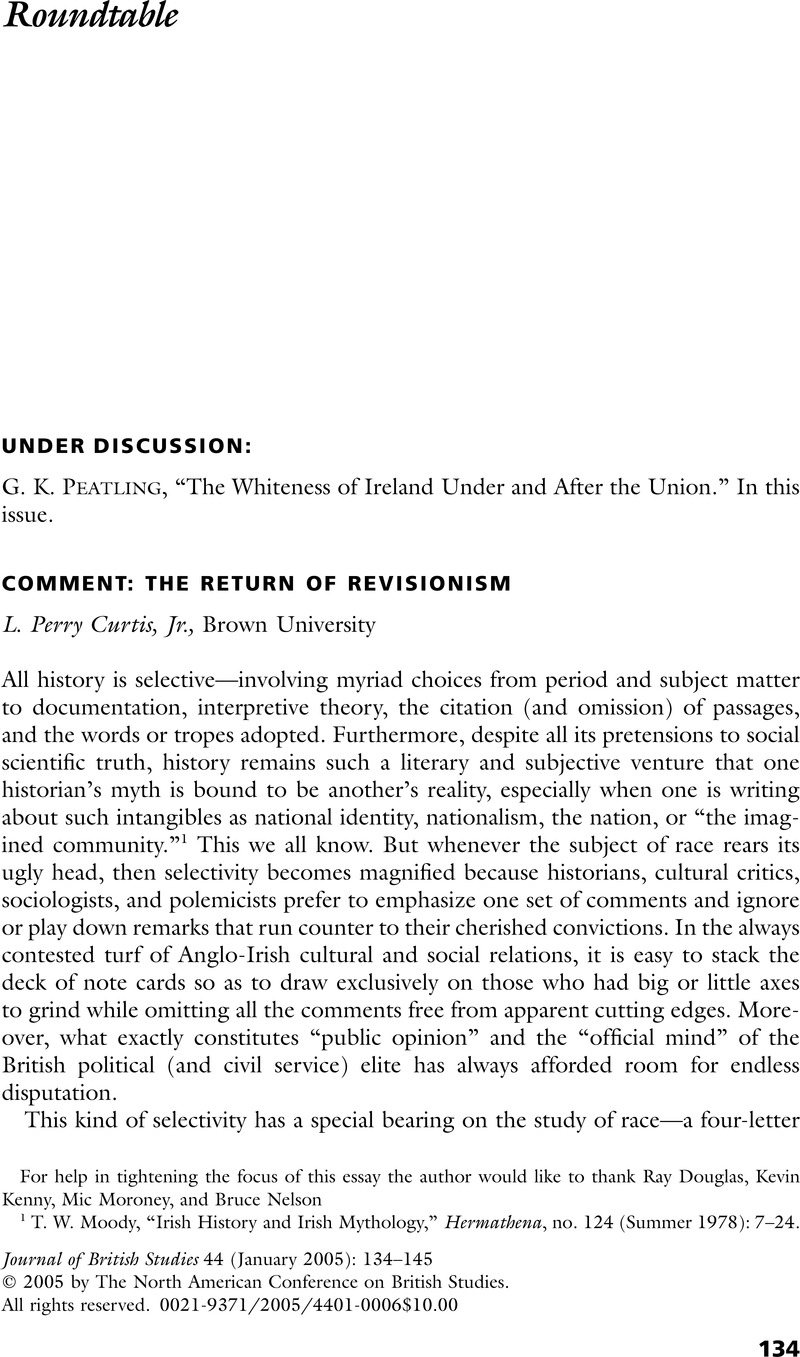Article contents
The Whiteness of Ireland Under and After the Union. Comment: The Return of Revisionism
Published online by Cambridge University Press: 21 December 2012
Abstract

- Type
- Roundtable: G. K. Peatling, “ The Whiteness of Ireland Under and After the Union”
- Information
- Copyright
- Copyright © North American Conference of British Studies 2005
References
For help in tightening the focus of this essay the author would like to thank Ray Douglas, Kevin Kenny, Mic Moroney, and Bruce Nelson
1 Moody, T. W., “Irish History and Irish Mythology,” Hermathena, no. 124 (Summer 1978): 7–24Google Scholar.
2 Curtis, L. P. Jr., Anglo-Saxons and Celts: A Study of Anti-Irish Prejudice in Victorian England (Bridgeport, Conn., 1968) (hereafter ASC), p. 62Google Scholar.
3 For Gilley's critique, see “English Attitudes to the Irish in England, 1780–1900,” in Immigrants and Minorities in British Society, ed. Holmes, Colin (London, 1978), pp. 81–110Google Scholar.
4 For my response to Gilley, see Curtis, L. P. Jr., Apes and Angels: The Irishman in Victorian Caricature, rev. ed. (Washington, D.C., 1997), esp. pp. 109–13Google Scholar
5 Kingsley wrote: “I am haunted by the human chimpanzees I see along that hundred miles of horrible country. I don’t believe they are our fault. … But to see white chimpanzees is dreadful; if they were black, one would not feel it so much, but their skins, except where tanned by exposure, are as white as ours.” Quoted in Curtis, ASC, p. 84.
6 Gibbons, Luke, “Race against Time: Racial Discourse and Irish History,” in his Transformations in Irish Culture (Cork, 1996), pp. 149–50Google Scholar.
7 As Sullivan, A. M. once noted, many English men and women thought “all Irishmen wear ‘caubeens,’ with pipes stuck in the rim, and carrying a reaping-hook under their flannel vest.” New Ireland, 6th ed. (London, 1878), p. 128Google Scholar. See also Curtis, Apes and Angels, pp. 191–92, n. 198.
8 For English racializing of the indigenous Irish in the early modern era, see Garner, Steve, Racism in the Irish Experience (London, 2004), chap. 3, pp. 74–81Google Scholar.
9 Roediger, David R., The Wages of Whiteness: Race and the Making of the American Working Class (New York, 1991), esp. pp. 133–50Google Scholar.
10 Beddoe, John, The Races of Britain (Bristol and London, 1885), pp. 2–11, 219–20, 223–24, 268Google Scholar. According to Beddoe the highest “Index of Nigrescence” was found among the Celts of Wales, western Ireland, and the Scottish Highlands.
11 O’Day, Alan, “Home Rule and the Historians,” in The Making of Modern Irish History: Revisionism and the Revisionist Controversy, ed. Boyce, D. George and O’Day, Alan (London and New York, 1996), esp. pp. 148, 159Google Scholar.
12 These and similar observations may be found in de Nie, Michael, The Eternal Paddy: Irish Identity and the British Press, 1798–1882 (Madison, Wisc., 2004), esp. pp. 117–19Google Scholar.
13 Bolt, Christine, Victorian Attitudes to Race (London, 1971)Google Scholar; Stepan, Nancy, The Idea of Race in Science: Great Britain, 1800–1960 (London, 1982)CrossRefGoogle Scholar; Stocking, George W. Jr., Victorian Anthropology (New York, 1987)Google Scholar.
14 Quoted in Boyce, D. George, Nationalism in Ireland (London, 1991), p. 215Google Scholar. Andrew Boyle contends that Childers's cogent argument in favor of Home Rule had little impact on the bitter debates between 1912 and 1914. The Riddle of Erskine Childers (London, 1977), pp. 166–67Google Scholar.
15 Curtis, ASC, pp. 100–104.
16 These comments by Bretherton, Charles, Douglas, Lord Alfred, and Pim, Herbert appear in R. M. Douglas, “Anglo-Saxons and Attacotti: The Racialization of Irishness in Britain between the Wars,” Ethnic and Racial Studies 25, no. 1 (January 2002): 40–63, esp. 45–48Google Scholar.
17 Childers, Erskine, The Framework of Home Rule (London, 1911), p. xvGoogle Scholar.
18 Quoted in Douglas, “Anglo-Saxons and Attacotti,” pp. 41–44.
19 Hickman, Mary J., “Alternative Historiographies of the Irish in Britain: A Critique of the Segregation/Assimilation Model,” in The Irish in Victorian Britain, ed. Swift, Roger and Gilley, Sheridan (Dublin, 1999), pp. 236–53Google Scholar. See also Fitzpatrick, David, “A Curious Middle Place: The Irish in Britain, 1871–1921,” in The Irish in Britain, 1815–1939, ed. Swift, Roger and Gilley, Sheridan (London, 1989), pp. 10–59Google Scholar.
20 Carroll, Clare and King, Patricia, eds., Ireland and Postcolonial Theory (Notre Dame, Ind., 2003), p. 3Google Scholar.
21 Cohen, 's assertion appears in Multi-racist Britain, ed. Cohen, Philip and Bains, Harwant S. (Basingstoke, 1988), p. 74, as quoted in Peatling, pp. 116-17CrossRefGoogle ScholarPubMed.
22 Tuathaigh, Gearóid Ó, “The Irish in Nineteenth-Century Britain: Problems of Integration,” Transactions of the Royal Historical Society 31 (1981): 149–74CrossRefGoogle Scholar; and Kevin Kenny, “Violence, Race, and Anti-Irish Sentiment in the Nineteenth Century” (paper presented at Oxford University, 25 May 2004). I am most grateful to Professor Kenny for sharing with me his insightful essay on the racialization of the Irish in America that will appear in a forthcoming anthology edited by Professor Joe Lee.
23 De Nie, Eternal Paddy, esp. pp. 21, 33, 267.
24 Garner, Racism, p. 122.
25 Ibid., pp. 263–64, 267–68.
26 Ibid., p. 129.
27 “Knox on the Celtic Races,” Anthropological Review and Journal 6 (1868): 176–77Google Scholar. See also Knox, Robert, The Races of Men: A Fragment (London, 1850), pp. 321–24CrossRefGoogle Scholar.
28 Foster, Roy, “‘We Are All Revisionists Now,’” Irish Review 1 (1986): 1–5CrossRefGoogle Scholar. In the course of five pages Foster managed to apply the term “pieties” to antirevisionist history no less than five times.
29 Shaw, Bernard, The Matter with Ireland, ed. Greene, David H. and Laurence, Dan H. (London, 1962), p. 294Google Scholar.
30 Shaw, Bernard, “Preface for Politicians,” John Bull's Other Island (London, 1907), pp. xxxiv–xxxvGoogle Scholar.
- 1
- Cited by


